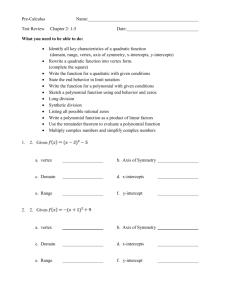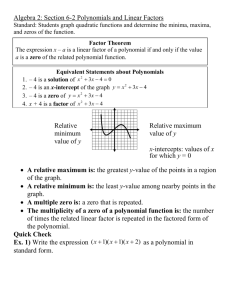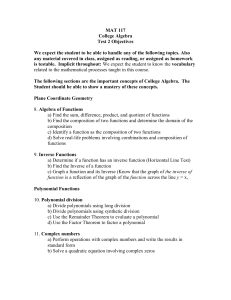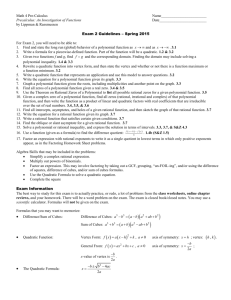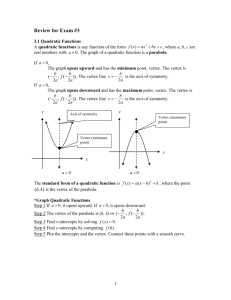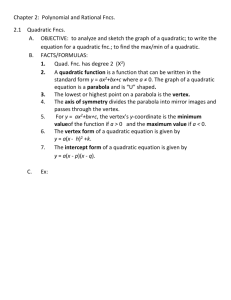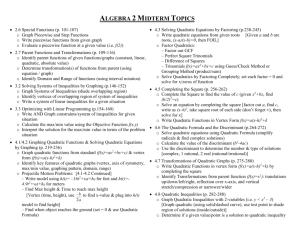print version
advertisement
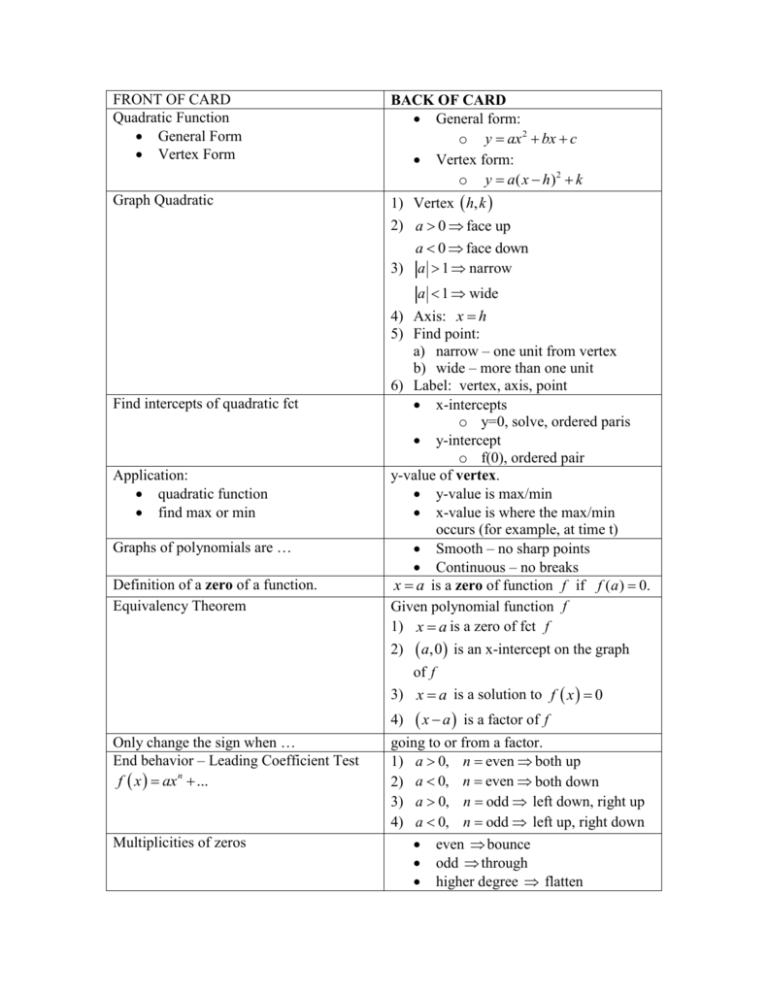
FRONT OF CARD Quadratic Function General Form Vertex Form BACK OF CARD General form: o y ax 2 bx c Vertex form: o y a( x h)2 k Graph Quadratic 1) Vertex h, k 2) a 0 face up a 0 face down 3) a 1 narrow a 1 wide Find intercepts of quadratic fct Application: quadratic function find max or min Graphs of polynomials are … Definition of a zero of a function. Equivalency Theorem 4) Axis: x h 5) Find point: a) narrow – one unit from vertex b) wide – more than one unit 6) Label: vertex, axis, point x-intercepts o y=0, solve, ordered paris y-intercept o f(0), ordered pair y-value of vertex. y-value is max/min x-value is where the max/min occurs (for example, at time t) Smooth – no sharp points Continuous – no breaks x a is a zero of function f if f ( a ) 0. Given polynomial function f 1) x a is a zero of fct f 2) a,0 is an x-intercept on the graph of f 3) x a is a solution to f x 0 4) Only change the sign when … End behavior – Leading Coefficient Test f x ax n ... Multiplicities of zeros x a is a factor of f going to or from a factor. 1) a 0, n even both up 2) a 0, n even both down 3) a 0, n odd left down, right up 4) a 0, n odd left up, right down even bounce odd through higher degree flatten Intermediate Value Theorem (IVT) A polynomial function of degree n has … turning points Graphing a polynomial Rational zero theorem Find all zeros of a polynomial fct Find all solutions to a polynomial equation Imaginary zeros always … A poly of degree n has … zeros Rational fct: find vertical asymptotes Rational fct: find horizontal asymptotes ax m ... f ( x) n bx ... Slant Asymptote If: 1) f is a polynomial function 2) a b 3) f (a ) and f (b) are opposite in sign Then: f has at least one zero in a, b at most n 1 turning points 1) End behavior 2) Zeros: a) x=zero b) multiplicity c) means … 3) Find points as needed 4) Draw graph 5) Label f ( x ) an x n ... a0 a factors of 0 are possible rational zeros an Graph - x-int Divide Synthetically Quadratic formula Graph - x-int Divide Synthetically Quadratic formula … come in conjugate pairs exactly n Set the denominator equal to zero and solve 1) deg num < deg denom y 0 a 2) deg num = deg denom y b deg num > deg denom no HA When the degree of the numerator is exactly one more than the degree of the denominator. 1) Divide denominator into numerator 2) Throw away the remainder 3) 3) SA is y quotient Solve polynomial inequalities graphically Solve polynomial inequalities algebraically Solve rational inequalities algebraically Direct variation Inverse variation Joint variation Combined variation Solve a variation problem 1) If poly > 0, then choose intervals where the graph is above the x-axis. 2) If poly < 0, then choose intervals where the graph is below the x-axis. 3) , use parenthesis , use brackets 1) Write as equation and solve to find boundary points. 2) Put boundary points on a number line and use test points from each interval in the original inequality. 3) Include all “yes” intervals in the solution. Same process as solving polynomial inequalities, except: 1) When finding boundary points, include any undefined values (denom = 0) 2) Can’t include in the solution any boundary points that are undefined. y kx k y x y varies as the product of two or more quantities: y kxz y varies both directly and inversely x yk z 1) Write variation model 2) Plug in values and solve for constant k 3) Re-write var model with value for k 4) Plug in values and solve for y

